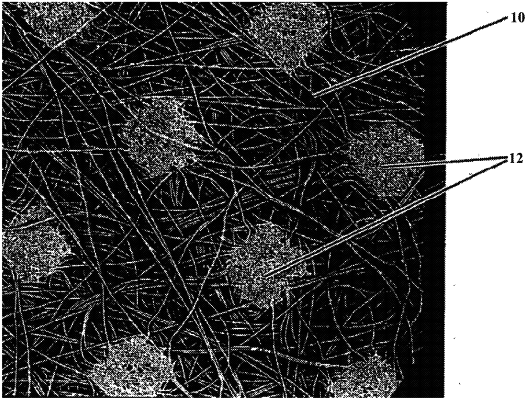| CPC D04H 1/492 (2013.01) [A61F 13/00 (2013.01); B32B 3/30 (2013.01); B32B 5/02 (2013.01); B32B 5/022 (2013.01); B32B 5/06 (2013.01); B32B 5/08 (2013.01); B32B 5/26 (2013.01); B32B 7/05 (2019.01); B32B 7/12 (2013.01); B32B 37/20 (2013.01); D04H 1/485 (2013.01); D04H 1/498 (2013.01); D04H 3/14 (2013.01); B32B 2250/20 (2013.01); B32B 2262/0253 (2013.01); B32B 2262/0276 (2013.01); B32B 2262/12 (2013.01); B32B 2262/14 (2013.01); B32B 2305/20 (2013.01); B32B 2307/40 (2013.01); B32B 2307/4023 (2013.01); B32B 2307/50 (2013.01); B32B 2307/54 (2013.01); B32B 2307/554 (2013.01); B32B 2307/718 (2013.01); B32B 2307/726 (2013.01); B32B 2307/728 (2013.01); B32B 2307/75 (2013.01); B32B 2310/0409 (2013.01); B32B 2432/00 (2013.01); B32B 2555/02 (2013.01)] | 13 Claims |

|
1. A process for forming a hydroentangled composite, comprising:
(a) forming a first nonwoven web and thermally bonding the first nonwoven web at a first thermal bonding energy, forming a second nonwoven web and thermally bonding the second nonwoven web at a second thermal energy, and wherein the second thermal bonding energy is at least 5% greater than the first thermal bonding energy, and wherein the first nonwoven web consists of a plurality of first individual fibers consisting of a polypropylene polymer and a hydrophilic additive and the second nonwoven web consists of a second plurality of individual fibers consisting of the polypropylene polymer and the hydrophilic additive;
(b) positioning the first nonwoven web proximate to at least one fluid jet and distal to an imaging sleeve, and positioning the second nonwoven web proximate or adjacent the imaging sleeve; and
(c) hydroentangling the first nonwoven web and the second nonwoven web together comprising applying at least one jet of fluid directly or indirectly to the first nonwoven web to impart a three-dimensional pattern onto the nonwoven material and form the hydroentangled composite;
wherein a weighted linting level (WLL) ratio between the second nonwoven web and the first nonwoven web prior to hydroentangling comprises a value of less than 0.9, and where WLL is defined as follows—
WLL=(L*BWt);
wherein (i) ‘L’ is the linting level for a given nonwoven web as determined by WSP 400.0 (05) modified by using a travel setting of 150 and a sample size of 75×425 mm in which the linting level is an average value for the first outer surface and the second outer surface (“modified WSP”), and (ii) ‘BWt’ is the basis weight of the given nonwoven web as determined by ASTM D3776; and
wherein the hydroentangled composite further comprises a linting level for the composite of 2 g/m2 to 5 g/m2 in which the linting level for the composite is an average value for a first outer surface of the hydroentangled composite and a second outer surface of the hydroentangled composite.
|